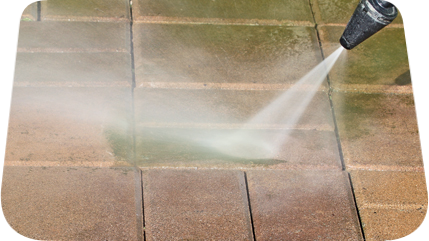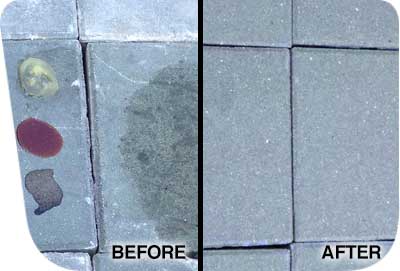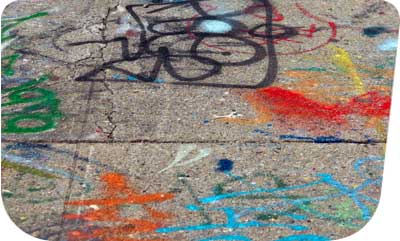 Concrete Sealer Remover Concrete Sealer Remover
A question many people have is how to remove an acrylic concrete sealer. That depends on a few factors including what kind of sealer was used. Was this concrete sealed with a water or solvent base sealer? If you did not apply the original sealer, you can run a very simple test to find out which base was used. Take a small amount of Xylene and place it on the area that is still covered with the sealer and let it stand for 20 seconds. Remove any excess Xylene and touch the area. If it's sticky, the surface was sealed with a solvent-base, if it isn't sticky it was sealed with a water-based.
That said, a solvent-based can be applied to the previous sealant if it was also a solvent-based. If on the other hand, the previous sealant was a water-based you cannot apply a solvent-based sealant until the original sealant has been completely removed from the surface. This is because if you apply a solvent-based on to the water-based, both solvents will eat away at both solvent and water bases and destroy both coatings.
A water-based sealer can be removed using chemical etching, pressure washing or by mechanical cutting.
If you originally applied a solvent-based and now want a water-based sealant, you will have to remove the solvent-base first because the water-based sealant will not be able to adhere to the solvent-based sealant. You will have to first remove any signs of chipping and peeling from the surface and then apply a solvent-based stripper like Xylene to remove the sealer. Follow this with a pressure washing to the surface and then allow it to completely dry. After it has dried you can apply the water-based sealant.
Keep in mind, if your concrete was stained or dyed using Xylene, it can damage or change the color of the concrete. If you want to add a new solvent-based sealant, you can just apply the new solvent directly unto the concrete without having to go through removing the old sealer. You should still remove any signs of peeling or chipping before applying the new sealant.
If your concrete was previously treated with a water-based sealer and you want to remove it, there are many fine products that will remove this coating such as Aqua Mix's Sealer & Coating Remover. You can also apply a chemical etching, pressure washing or mechanical cutting.
Using Chemical Concrete Sealer Remover
Anyone who has ever stripped a sealant or coating off concrete knows how really horrible the process is. Removing old, worn out or failing sealants and/or coatings are just a miserable process and you might have to look for professional help. Unfortunately, this could be the only way to restore, repair, and prepare the surfaces of the concrete properly.
Sealant Removal Options:
There are 2 options for removing sealants from concrete. The mechanical method will require grinding, blasting, or sanding the coating off of the surface. The other method is using a chemical stripper to remove the coating or sealant. While both methods work, the mechanical approach can damage the surface to the level that translucent finishes cannot be applied. It also creates a great deal of dust and debris that is usually very difficult to get around. Using the chemical stripping approach is the most popular choice for removing sealants, coatings, and paints from your concrete surfaces.
There are three kinds of chemical strippers - caustic, solvent-based, and biochemical. They are all available at hardware stores, specialty outlets for paint supplies, and other centers that deal with concrete. Keep in mind, whatever kind of chemical stripper you choose, you must read all the safety guidelines and follow them exactly. Chemical strippers contain elements that can harm your health so treat them properly and get rid of material waste that is set down by local and state regulations.
 What Is The Best Stripping Sealant Method? What Is The Best Stripping Sealant Method?
Many researchers and professionals in the concrete industry are often asked similar questions such as the best approach for stripping sealants and the best products on the market that will do the best job. So, in this post, we are going to address those questions. Before you can decide what would be the best way to remove a sealant from concrete, you have to understand what kind of sealant you are removing.
As all sealants are not alike, it is strongly believed that polyurethanes and epoxies are much thicker and the best choices. That said, they also take longer to remove where thinner acrylic products work much faster.
The are two methods commonly used for stripping an old sealant are chemical and mechanical.
Chemical strippers break down the polymer structure of the sealant. The chemicals destroy the sealant by turning it into a sludge.
The Mechanical approach for removing sealants requires equipment to grind or blast off the sealant. The most common mechanical approaches are bead blasting, scarifying, grinding, and shot-blasting. Keep in mind, if using the mechanical method, you must be very careful not to damage the substrate below. You should try a softer shot or beads such as finely ground corn husks or seed hulls.
Without a doubt, the most popular and effective approach is using a chemical stripper. This is strongly advised for decorative concrete. You want to maintain the color and profile of the concrete which is extremely important. Chemical strippers have changed drastically over the years, providing more environmentally friendly products. The development of new chemical strippers is safer for the environment, including soy-based strippers or citrus-based strippers. These new strippers use natural compounds and oils to break down the sealant and are a great deal safer.
 There are aggressive chemical strippers that contain methylene chloride that work very quickly. While these strippers have been successfully used for many years for removing paints and coatings, they are highly volatile and potentially dangerous to the environment and those working with the products. There are aggressive chemical strippers that contain methylene chloride that work very quickly. While these strippers have been successfully used for many years for removing paints and coatings, they are highly volatile and potentially dangerous to the environment and those working with the products.
In many cases, it really depends on the time you are allotting to finish the project vs safety and environmentally friendliness.
The entire process of stripping sealants from concrete will take a good deal of time while keeping the product damp. Chemical strippers only work when they are active and therefore many come in a gel form. Gels are excellent for keeping the stripper damp for a longer period of time.
Natural products work much slower and therefore it's a real challenge to keep the stripper damp. A good tip for keeping the product wet, cover the stripper with a damp cotton sheet. A thin bed sheet will keep the stripper moist and will absorb the dissolved sealant for removal.
This step might have to be repeated depending on the kind of sealant, the kind of stripper, and the surface you are working with. Without a doubt, stamped concrete with textures and grooves is the most difficult to work with. Once the sealant has dissolved, you will have to perform a really good cleaning afterward, even if the bed sheet has pulled up the dissolved sealant.
You might decide to remove the sludge with a high-pressure warm water wash followed by a cleaning with soap and water to remove any remaining debris. Once washed, you should perform a thorough rinsing and then give it plenty of time to dry out. Your concrete must be thoroughly dry before applying a new coat of sealant.
|